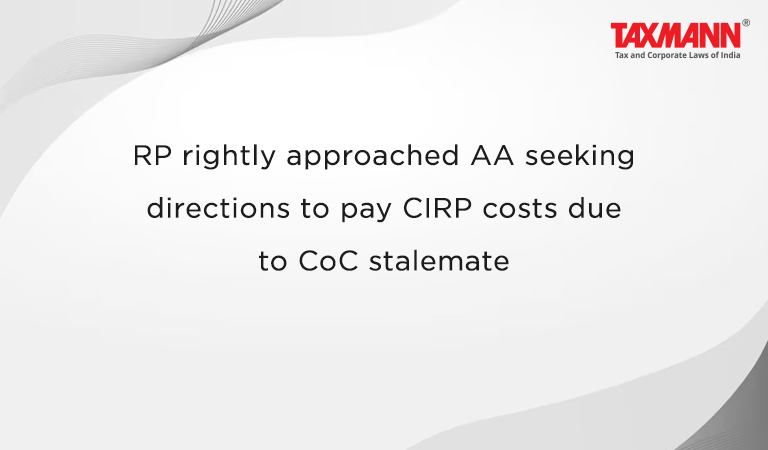RP rightly approached AA seeking directions to pay CIRP costs due to CoC stalemate
- Blog|News|Insolvency and Bankruptcy Code|
- 2 Min Read
- By Taxmann
- |
- Last Updated on 21 March, 2023

Case Details: Income-tax Department, Assistant Commissioner of Income-tax, Delhi v. Indianroots Shopping Ltd. - [2023] 147 taxmann.com 557 (NCLAT-New Delhi)
Judiciary and Counsel Details
-
- Rakesh Kumar Jain, Judicial Member & Dr Alok Srivastava, Technical Member
- Vipul Agarwal & Parth S., Jr. Standing Counsel for the Appellant.
- Ms. Prachi Johri & Vatsalya Kumar, Advs. for the Respondent.
Facts of the Case
In the instant case, the Corporate Insolvency Resolution Process (CIRP) was initiated against the corporate debtor and a Resolution Professional (RP) was appointed. Since no claim was received from any financial creditor, the Committee of Creditors (CoC) was constituted with operational creditors only.
Later, the RP filed an application before the adjudicating authority i.e., NCLT seeking directions for the appellant (i.e. operational creditors) to pay CIRP dues and expenses in proportion to their voting share in CoC. The NCLT by the impugned order, directed the appellants to deposit the amount immediately.
Consequently, the appellants challenged the NCLT’s order on the ground that the appellants holding a total voting share of 96.75% could not attend the 7th CoC meeting, and the decision taken in the said meeting regarding fixing of the CIRP costs and their allocation for payment was not made in compliance with section 21 of IBC. Further, it was also noted that the appellants had chosen not to be present in the CoC meeting.
NCLAT Held
The NCLAT observed that since the appellants holding 96.75% shares in the corporate debtor chose not to participate in the CoC meeting, any decision taken in the said meeting would not have been taken with more than 51% voting share. Therefore, compliance with section 21(8) of the IBC would have been impossible.
The NCLAT held that since the appellants had refused to participate in the CoC meeting thereby causing a stalemate, RP was correct in approaching the NCLT for seeking necessary directions for the appellants to pay the CIRP costs. Therefore, there was no error in the impugned order passed by the NCLT.
List of Cases Reviewed
-
- AS Technosoft (P.) Ltd. v. Indianroots Shopping Ltd. [2023] 147 taxmann.com 556 (NCLT – New Delhi) (Para 21) [ See Annex]
List of Cases Referred to
-
- Committee of Creditors v. B. Santosh Babu [2020] 118 taxmann.com 146 (NCLAT – New Delhi) (para 13)
- K. Sashidhar v. Indian Overseas Bank [2019] 102 taxmann.com 139/152 SCL 312/213 Comp Case 356 (SC)/[2019] 12 SCC 150 (para 13).
Disclaimer: The content/information published on the website is only for general information of the user and shall not be construed as legal advice. While the Taxmann has exercised reasonable efforts to ensure the veracity of information/content published, Taxmann shall be under no liability in any manner whatsoever for incorrect information, if any.

Taxmann Publications has a dedicated in-house Research & Editorial Team. This team consists of a team of Chartered Accountants, Company Secretaries, and Lawyers. This team works under the guidance and supervision of editor-in-chief Mr Rakesh Bhargava.
The Research and Editorial Team is responsible for developing reliable and accurate content for the readers. The team follows the six-sigma approach to achieve the benchmark of zero error in its publications and research platforms. The team ensures that the following publication guidelines are thoroughly followed while developing the content:
- The statutory material is obtained only from the authorized and reliable sources
- All the latest developments in the judicial and legislative fields are covered
- Prepare the analytical write-ups on current, controversial, and important issues to help the readers to understand the concept and its implications
- Every content published by Taxmann is complete, accurate and lucid
- All evidence-based statements are supported with proper reference to Section, Circular No., Notification No. or citations
- The golden rules of grammar, style and consistency are thoroughly followed
- Font and size that’s easy to read and remain consistent across all imprint and digital publications are applied





